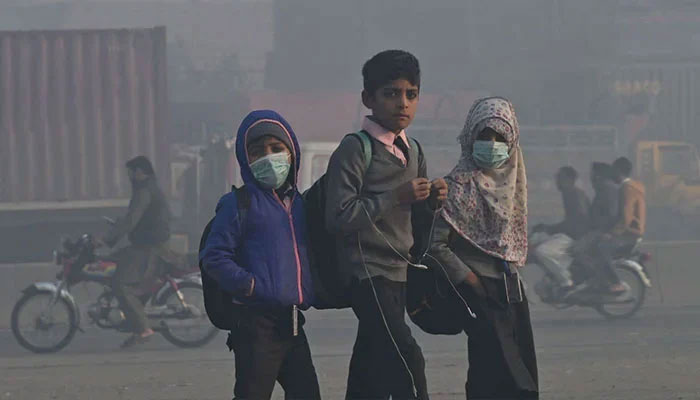Battling the grey
Every winter, environment experts check Air Quality Index to see how much ‘poison’ they are inhaling
Winter has become the most dangerous, unbearable and harmful season in Punjab. The air in the province, particularly in Lahore and surrounding areas, becomes increasingly hazardous, casting a thick, gray shroud over daily life. Previously, the provincial government had conveniently placed the blame on farmers’ stubble-burning activity, a regular feature at the end of the harvesting season. The government had thus introduced short-term and agriculture-specific measures to somehow reverse the climatic change. But it became apparent within a short period that this was too little – and probably also too late. From school closures to artificial rains, the Punjab government has so far tried numerous measures to tackle smog. But the problem has not budged. Every winter, people in Punjab, particularly Lahore, and environment experts regularly check the Air Quality Index to see how much ‘poison’ they are inhaling. Climate experts equate the inhaling of Lahore’s air to the number of cigarettes one has smoked – with the comparison leading to around 14 cigarettes a day. In 2023, Pakistan ranked as the second most polluted country, and Lahore was the fourth most polluted city in the world. This necessitated a policy shift, and, thankfully, the provincial government has realized that this issue requires all state departments to work together to keep the province clear of the awful smog.
The Punjab Environment Protection and Climate Change Department (EPCCD) has now decided to treat smog as a year-round epidemic with CM Punjab Maryam Nawaz adopting a ‘prevention is better than cure’ approach. The provincial government has announced the commencement of the second phase of its ambitious anti-smog campaign. The CM’s directive for strict law enforcement under the Smog-Free Punjab vision is a welcome development. The first phase of the campaign focused on providing facilities, technical assistance, equipment, and technology to combat smog, laying the groundwork for a more robust and effective second phase. The second phase promises a stringent crackdown on violations of environmental laws. This includes a crackdown on brick kiln owners who have not implemented Zigzag Technology, vehicles emitting smoke, industrial emissions, and individuals burning garbage, rubber, or agricultural waste. The government will also encourage carpooling and the use of public transport to bring pollution levels down. All this sounds great on paper, but we have to see how successfully the Punjab government can implement these steps. While successive governments have been quick at launching what they call foolproof and coherent plans to arrest the problem, we have seen them failing at implementing them.
The Punjab government’s latest plan is good so much so that it may convert its critics into its motivator. But a critical question is if the government is interested in adopting a zero-tolerance approach to implement its plan. Industries must adopt cleaner technologies and adhere to environmental regulations to reduce their carbon footprint. The fines and penalties must be substantial enough to act as deterrents, ensuring compliance. Traffic emissions also play a significant role in deteriorating air quality. The government must invest in and promote public transportation, encourage carpooling, and consider policies to reduce the number of vehicles on the road during peak smog seasons. Incentives for electric and hybrid vehicles could also be part of a broader strategy to reduce vehicular emissions. The enforcement of these regulations will require robust monitoring systems and the active involvement of law-enforcement agencies. Leniency at any level or a free pass to those closer to government officials can undo the government’s initiative, bringing everyone back to the starting point.
-
 How Princes William, Harry Were Caught In Early Royal Controversy Involving Charles
How Princes William, Harry Were Caught In Early Royal Controversy Involving Charles -
 Prince Harry’s Absence Leaves Gap For Royal Family Among Young People
Prince Harry’s Absence Leaves Gap For Royal Family Among Young People -
 Karley Scott Collins Breaks Silence On Keith Urban Dating Rumours
Karley Scott Collins Breaks Silence On Keith Urban Dating Rumours -
 Timothee Chalamet Is Still A 'normal Guy,' Says Kevin O'Leary
Timothee Chalamet Is Still A 'normal Guy,' Says Kevin O'Leary -
 Henry Winkler Opens Up On His Special Bond With Adam Sandler: 'Filled With Warmth'
Henry Winkler Opens Up On His Special Bond With Adam Sandler: 'Filled With Warmth' -
 Bruce Springsteen Makes Strong Political Statement
Bruce Springsteen Makes Strong Political Statement -
 Prince Harry Relationship With King Charles 'not Straightforward,' Says Expert
Prince Harry Relationship With King Charles 'not Straightforward,' Says Expert -
 Truth Behind Jennifer Lopez's 'rude' Glambot Moment Laid Bare
Truth Behind Jennifer Lopez's 'rude' Glambot Moment Laid Bare -
 Nicole Richie Still Loves This Makeup Trend From Her Teen Years
Nicole Richie Still Loves This Makeup Trend From Her Teen Years -
 Meghan Markle Plans To Hide Behind Kids Over Return To UK
Meghan Markle Plans To Hide Behind Kids Over Return To UK -
 Dolly Parton Marks Major Milestone As State Governor Honors Her Legacy
Dolly Parton Marks Major Milestone As State Governor Honors Her Legacy -
 Karley Scott Collins Reacts To Rumours Of Her Dating Keith Urban
Karley Scott Collins Reacts To Rumours Of Her Dating Keith Urban -
 Meghan Markle Sends Shockwaves With Promise Of Chaos: ‘Has The Power To Upset The Royals’
Meghan Markle Sends Shockwaves With Promise Of Chaos: ‘Has The Power To Upset The Royals’ -
 Jesy Nelson, Zion Foster Call It Quits Amid Twins' Heartbreaking Diagnosis: Source
Jesy Nelson, Zion Foster Call It Quits Amid Twins' Heartbreaking Diagnosis: Source -
 What King Charles Told Princess Diana In Letter Before Wedding?
What King Charles Told Princess Diana In Letter Before Wedding? -
 David Crosby Said This One Singer Had 'no Talent At All'
David Crosby Said This One Singer Had 'no Talent At All'




